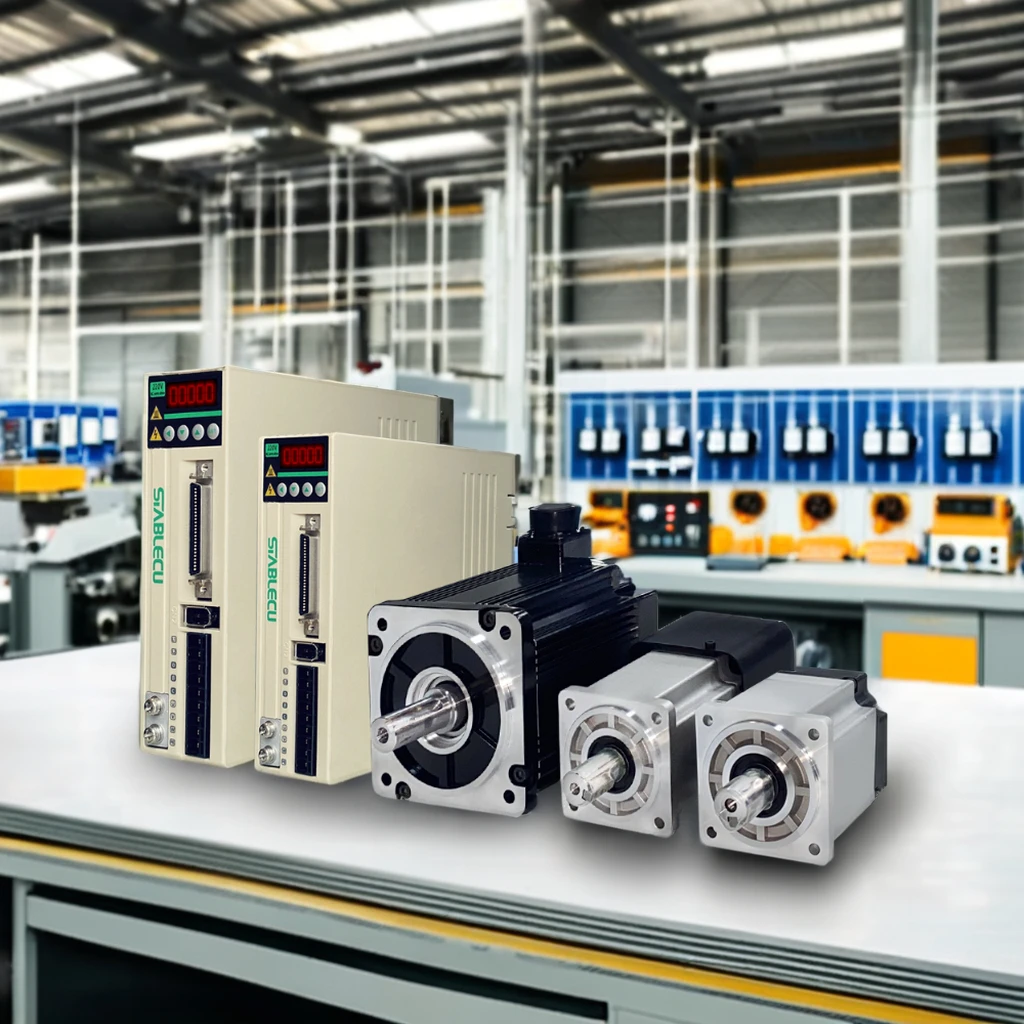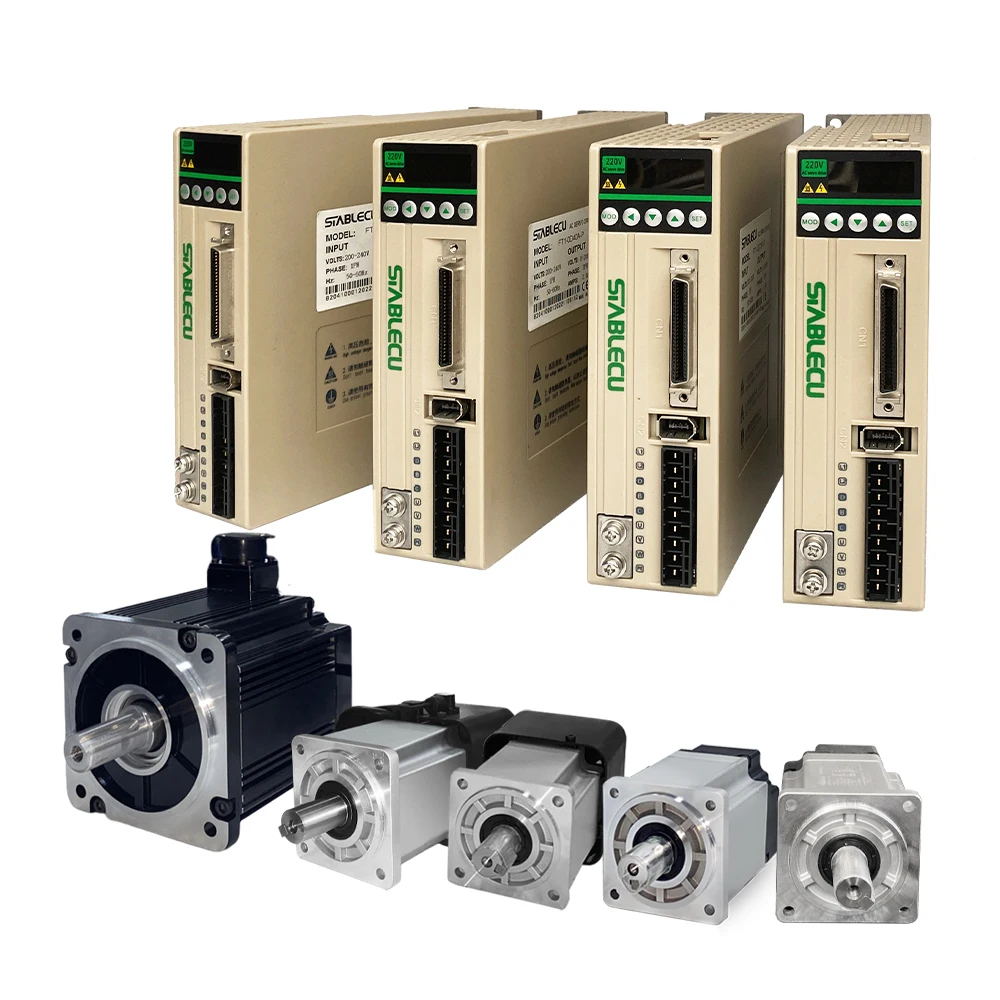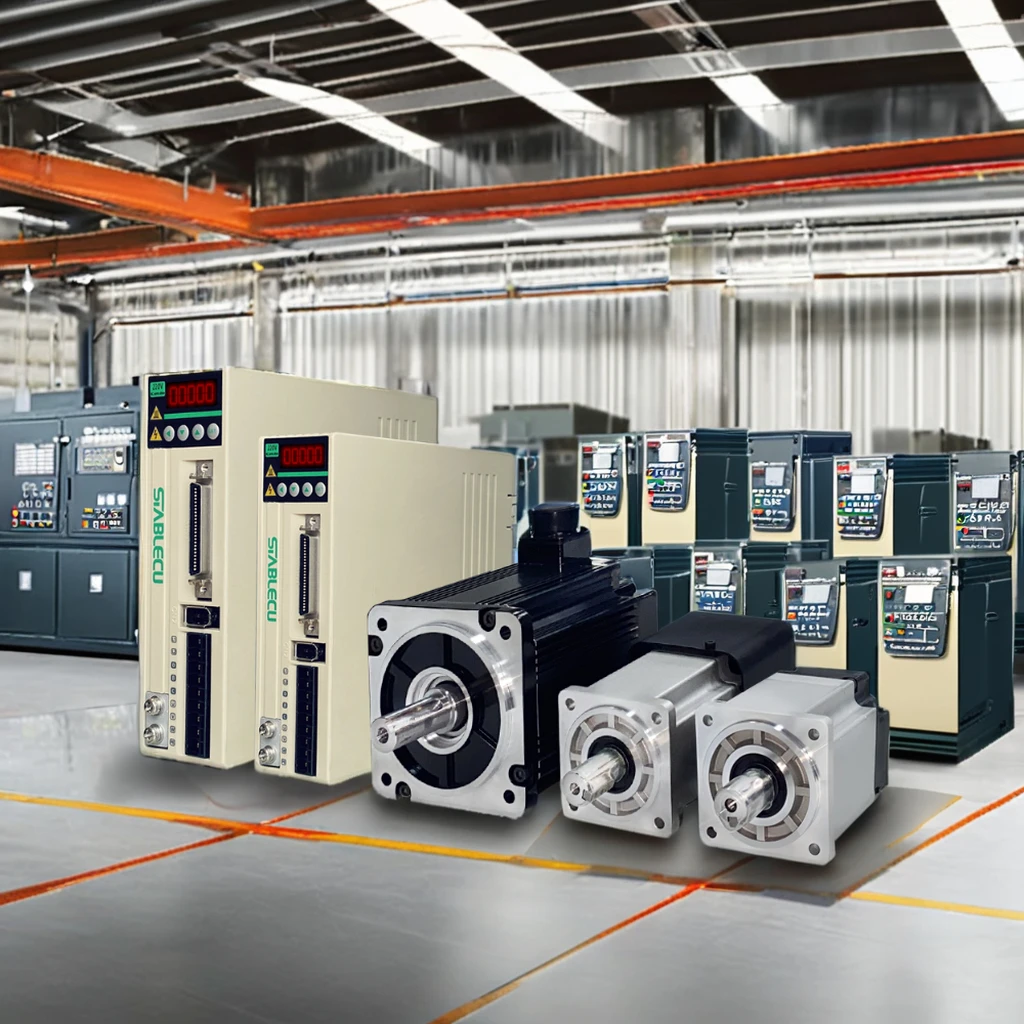Az AC szervomotor működési elve és előnyei
Az AC szervomotorok megértése
Az AC szervomotor egy elektromos motor, amelyet arra terveztek, hogy precíz vezérlést biztosítson a szöghelyzetben, a sebességben és a gyorsulásban visszacsatoláson és zárt hurkú vezérlőrendszereken keresztül. A hagyományos motorokkal ellentétben az AC szervomotorok folyamatosan kapnak visszajelzést, amely segít a helyzetük és sebességük beállításában és finomhangolásában, ami nagy pontosságot eredményez. Ezek a motorok alapvetően az aktuális pozíció és a kívánt teljesítmény összehasonlításával működnek, biztosítva, hogy elérjék és fenntartsák a különböző alkalmazásokhoz szükséges megfelelő szögeltolódást vagy mozgást.
Az AC szervomotorok jelentőségét az automatizálásban nem lehet túlbecsülni. Pontosságuk és hatékonyságuk nélkülözhetetlenné teszi a robotikában és más automatizálási technológiákban, a modern gyártási folyamatok szerves alkotóelemeiként. Ezek a motorok létfontosságúak olyan forgatókönyvekben, ahol a precizitás kulcsfontosságú, például CNC-gépekben vagy robotkarokban. Lehetővé teszik az azonnali alkalmazkodást és a változó körülményekhez való alkalmazkodást, segítve az iparágakat a termelékenység és az innováció növelésében, miközben megőrzik a minőséget és a pontosságot.
AC szervomotorok építése
A váltóáramú szervomotorok olyan alapvető alkatrészekből állnak, mint az állórész és a forgórész, amelyek kulcsfontosságúak a teljesítmény és a hatékonyság meghatározásában. Az állórész, az állórész, két tekercsből áll - a fő- és a vezérlőtekercsből -, amelyek egymástól 90°-ban vannak elhelyezve. A fő tekercs állandó váltóáramú jelet kap, míg a vezérlő tekercset változó vezérlőfeszültség táplálja, ami elengedhetetlen a forgó mágneses tér létrehozásához. A rotor, amely jellemzően alumíniumból készült mókusketrec, nagy ellenállással és alacsony tehetetlenséggel rendelkezik, hogy növelje a stabilitást és a lineáris nyomatékcsökkenést a sebességgel. Ez a kialakítás rendkívül stabil motort eredményez, amely kulcsfontosságú a különféle precíziós alkalmazásokhoz.
Az AC szervomotoroknak elsősorban két típusa van: szinkron és aszinkron (vagy indukciós) motorok, amelyek mindegyike eltérő felépítési jellemzőkkel és alkalmazásokkal rendelkezik. A szinkron váltakozó áramú szervomotorok fenntartják a szinkront a forgórész és az állórész mágneses mezői között, így precíz vezérlést biztosítanak a nagy pontosságú feladatokhoz. Másrészt az elektromágneses indukción alapuló aszinkron AC szervomotorokat robusztusságuk és költséghatékonyságuk miatt dicsérik, így ideálisak olyan alkalmazásokhoz, amelyek alacsony fordulatszámon nagy nyomatékot igényelnek. Mindkét típus nélkülözhetetlen az ipari automatizálásban, a robotikában és azon túl is, kiemelve sokoldalú használhatóságukat.
Az AC szervomotorok működési elve
A váltóáramú szervomotorok működését alapvetően a visszacsatoló rendszerek és vezérlőkörök hajtják, amelyek biztosítják a pontosságot. A legtöbb AC szervorendszer középpontjában a szervomotor meghajtók és vezérlők állnak. Ezek az alkatrészek döntő szerepet játszanak a motor helyzetének, fordulatszámának és nyomatékának beállításában a visszacsatoló eszközök, például a kódolók vagy a rezolverek bemenete alapján. Lényegében a rendszer folyamatosan figyeli a tényleges teljesítményt a kívánt alapértékekhez képest, és elvégzi a szükséges beállításokat, ezáltal precíz vezérlést és pontosságot tesz lehetővé.
A nyomaték-sebesség jellemzőinek megértése létfontosságú az adott feladatokhoz megfelelő AC szervomotor kiválasztásához. A nyomaték-sebesség görbe felvázolja a motor teljesítményét különböző terhelési feltételek mellett. Általában a motor fordulatszámának növekedésével a nyomaték csökken, amit a nyomaték-sebesség görbe ábrázol. Alacsony fordulatszámon nagy nyomatékot vagy alacsony nyomatékú nagy fordulatszámot igénylő alkalmazásoknál a görbe linearitása és meredeksége segít megalapozott döntéseket hozni a motorhasználattal kapcsolatban. Ezen jellemzők elemzésével a mérnökök biztosíthatják, hogy a kiválasztott motor hatékonyan megfeleljen az üzemeltetési igényeknek.
Áttérve a következő részre, az AC szervomotorok felépítése jelentős szerepet játszik ezen elvek alkalmazásában, befolyásolva mind a teljesítményt, mind a hatékonyságot.
AC szervomotorok alkalmazásai
A váltóáramú szervomotorokat a különböző iparágakban széles körben alkalmazzák pontosságuk és megbízhatóságuk miatt. A Autóipar , ezek a motorok döntő szerepet játszanak a gyártási folyamatokban, például az összeszerelő sorokban és a robotautomatizálásban. A Űripar A precíz mozgásvezérlést igénylő alkalmazásokban, például repülésszimulátorokban és repülőgép-műszerekben a váltakozóáramú szervomotorok előnyeit élvezi. Ezenkívül ezek a motorok gyakran megtalálhatók a Pakolás iparágakban, biztosítva a nagy sebességű, pontos mozgásokat szállítószalag-rendszerekben és CNC-gépekben.
Az automatizálás konkrét példái mutatják be az AC szervomotorok sokoldalúságát és hatékonyságát. Például be Robotika , ezek a motorok zökkenőmentes és pontos mozgásvezérlést biztosítanak, ami elengedhetetlen a nagy pontosságot igénylő feladatokhoz, mint például a pick-and-place műveletekhez. A Szövetipar Az AC szervomotorok jelentősen hozzájárulnak a szövéshez és kötéshez használt fejlett gépekhez, javítva a minőséget és a termelékenységet. Továbbá be Automatikus vezérlésű járművek (AGV-k) A logisztikában és a raktározásban használt AC szervomotorok egyenletes és hatékony mozgást biztosítanak, javítva az általános működési hatékonyságot. Ezeken a példákon keresztül nyilvánvaló, hogy az AC szervomotorok nemcsak a teljesítményt és a minőséget javítják, hanem az automatizált folyamatokon belül is jelentős hatékonyságjavulást eredményeznek.
Az AC szervomotorok használatának előnyei
Az AC szervomotorok jelentős előnyöket kínálnak a hatékonyság és a pontosság tekintetében. Ezek a motorok a hagyományos motorokhoz képest magas hatásfokukról ismertek. Például az AC szervomotorok akár 90%-os hatékonysági szintet is elérhetnek, minimalizálva az energiaveszteséget működés közben. Figyelemre méltó pontosságot is biztosítanak; mivel képesek a mozgást egy fok töredékén belül irányítani, elengedhetetlenek az aprólékos pontosságot igénylő alkalmazásokban, mint például a CNC gépek és a robotika. A kutatások azt mutatják, hogy a váltóáramú szervomotorok használata akár 15%-kal is javíthatja a pontosságot a szabványos motorokhoz képest, ami fokozott teljesítményt eredményez a kritikus ipari alkalmazásokban.
Ezenkívül az AC szervomotorok robusztusságukról és alacsony karbantartási igényükről híresek. Strapabíró felépítésük minimalizálja a kopást, ami csökkenti az állásidők és a műszaki beavatkozások gyakoriságát. Idővel ez a tartósság jelentős költségmegtakarítást jelent a gyártók számára, mivel ritkább karbantartásra és cserealkatrészekre van szükség. Az AC szervomotorok kezdeti magasabb költségét gyakran ellensúlyozzák ezek a hosszú távú megtakarítások és megbízhatóság. Figyelemre méltó, hogy számos iparág a karbantartási költségek akár 25%-os csökkenéséről számolt be a hagyományos motorokról váltóáramú szervomotorokra való átállással, ami bizonyítja azok gazdasági életképességét és megbízhatóságát az ipari környezetben.
Ajánlott AC szervomotor termékek
Azok számára, akik csúcskategóriás AC szervomotorokat keresnek, a következő termékek kifejezetten ajánlottak kivételes tulajdonságaik és teljesítményük miatt.
Forrón eladó 220V AC szervomotor meghajtó
Az iparágban mércét állítva a Forrón eladó 220V AC szervomotor meghajtó páratlan megbízhatóságot kínál 750 W teljesítményével és 2,4 Nm nyomatékával, 3000 ford./perc sebességgel. Ez a modell egy- és háromfázisú konfigurációkat is támogat, így sokoldalúan használható különféle alkalmazásokhoz.
Ipari használatra 750 W-os AC szervomotor és meghajtó
A Ipari használatra 750 W-os AC szervomotor és meghajtó kiemelkedik nagy sebességű képességével és robusztus kódoló funkcióival, akár 3000 ford./perc névleges működési sebességével. Számos vezérlési móddal és átfogó védelmi mechanizmusokkal van felszerelve, amelyek biztosítják a tartósságot és a hatékonyságot az ipari alkalmazásokban.
Energiatakarékos 220 V AC szervomotor meghajtókészlettel
A Energiatakarékos 220 V AC szervomotor meghajtókészlettel a hatékonyságot szem előtt tartva tervezték. Háromfázisú tápellátást biztosítva jelentős energiamegtakarítást biztosít, miközben fenntartja a nagy teljesítményű szabványt. Ez ideálissá teszi CNC és hasonló alkalmazásokhoz, amelyek precíz vezérlést és energiahatékonyságot igényelnek.

 EN
EN
 AR
AR
 BG
BG
 HR
HR
 CS
CS
 DA
DA
 NL
NL
 FR
FR
 DE
DE
 EL
EL
 HI
HI
 IT
IT
 JA
JA
 KO
KO
 PL
PL
 PT
PT
 RO
RO
 RU
RU
 ES
ES
 SV
SV
 CA
CA
 TL
TL
 ID
ID
 SR
SR
 UK
UK
 VI
VI
 SQ
SQ
 HU
HU
 TH
TH
 TR
TR
 FA
FA
 AF
AF
 MS
MS
 KA
KA
 BN
BN
 LA
LA
 TA
TA
 KK
KK
 UZ
UZ



